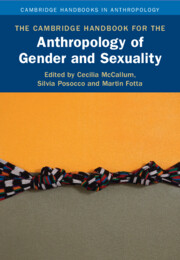Book contents
- The Cambridge Handbook for the Anthropology of Gender and Sexuality
- Cambridge Handbooks in Anthropology
- The Cambridge Handbook for the Anthropology of Gender and Sexuality
- Copyright page
- Contents
- Contributors
- 1 Introduction to The Cambridge Handbook for the Anthropology of Gender and Sexuality
- Part One Openings and Orientations
- Part Two Knowledges and Domains
- 6 Gender, Sociality, and the Person
- 7 The Postmodern Moment in Gender Studies and Anthropology
- 8 Gender(ed) Language and the Linguistics of Sexuality
- 9 Conceptualizing Bodies, Hierarchy, and Gendering across Cultures
- 10 Language, Gender and Sexuality, and Performativity
- 11 Anthropological Engagements with Men and Masculinities
- Part Three Resistances and Intersections
- Part Four Desires and Relations
- Part Five Recursivities and Futures
- Name Index
- Subject Index
- References
9 - Conceptualizing Bodies, Hierarchy, and Gendering across Cultures
from Part Two - Knowledges and Domains
Published online by Cambridge University Press: 29 September 2023
- The Cambridge Handbook for the Anthropology of Gender and Sexuality
- Cambridge Handbooks in Anthropology
- The Cambridge Handbook for the Anthropology of Gender and Sexuality
- Copyright page
- Contents
- Contributors
- 1 Introduction to The Cambridge Handbook for the Anthropology of Gender and Sexuality
- Part One Openings and Orientations
- Part Two Knowledges and Domains
- 6 Gender, Sociality, and the Person
- 7 The Postmodern Moment in Gender Studies and Anthropology
- 8 Gender(ed) Language and the Linguistics of Sexuality
- 9 Conceptualizing Bodies, Hierarchy, and Gendering across Cultures
- 10 Language, Gender and Sexuality, and Performativity
- 11 Anthropological Engagements with Men and Masculinities
- Part Three Resistances and Intersections
- Part Four Desires and Relations
- Part Five Recursivities and Futures
- Name Index
- Subject Index
- References
Summary
This chapter describes the range of cognitive perceptions about the body, drawn from ethnographic narrations of various cultures, with specific emphasis on South Asia, revealing a startling plurality of views and worldviews about it. These perceptions are both informed by and influence practices related to the body, especially those of gendering, hierarchization, and sexuality and exploitation. The intersection of the way bodies are conceptualized to the power hierarchies existing in any situation illuminates how bodies are both constructed and destroyed, explaining why some bodies are considered dispensable while others are considered as precious. The modern market and the commodification of the body leads to its final disintegration and dissolution as marketable parts, dehumanizing it to an ultimate nonhumanity. All these perspectives and practices are contextualized within historical, political, and material fields of power, giving them a dynamic character. The chapter also summarizes some of the key anthropological theorizations and philosophical interrogations about the body, tracing the discourse from classical to the recent postmodern and feminist perspectives.
Keywords
- Type
- Chapter
- Information
- Publisher: Cambridge University PressPrint publication year: 2023



